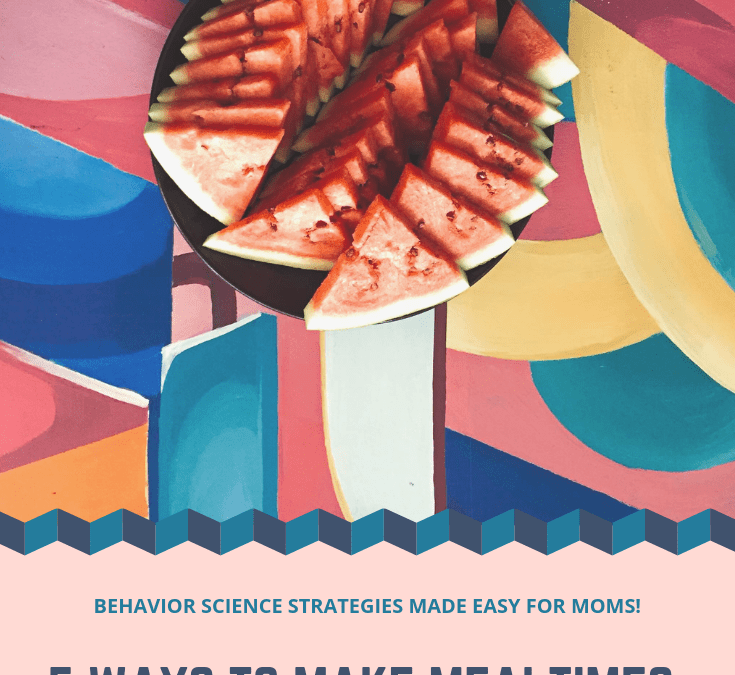A mom writes: Behavior BFF, my child totally loses his cool at dinnertime. Every. Single. Day. Is there a way to make dinnertime with toddlers less miserable??
First off, a little disclaimer: If your child has serious feeding issues, you need to seek individualized treatment from a professional. Start with your pediatrician and go from there. You can find Behavior Analysts in your area at www.bacb.com.
What I CAN help you with are some positive behavior support strategies to prevent entering a circle of hell when you sit down at the table with a toddler.
Let’s focus on preventing the tantrums, the throwing of food and utensils, and the tears. His and yours.
Do the problem behaviors happen at every meal or just dinner? If it’s just at dinner, let’s look at the setting events. Has it been a while since snack time and maybe he’s actually hungry? If yes, move your dinner or snack time. Or have two snack times. Shuffle your schedule to make sure he’s not going too long between eating opportunities.
Maybe it’s the reverse- is he too full from too many snacks? Hold off on the snacking, then. Make sure he isn’t filling up on snack foods he finds delicious only for you to turn around and put a plate of vegetables in front of him. He’s not hungry and those don’t look like whatever yummy snacks he had earlier. Fling- veggies on the wall!
What are you doing as he eats dinner? Are you sitting down together as a family or does the toddler eat earlier than the grown-ups? If he’s eating alone, is he engaging in the problem behaviors to try to get your attention? If he eats alone, try giving him more attention. Whatever other meal prep you are doing or clean up in the kitchen can wait. Sit with him and chat, just like you would with any other dinner date.
Do certain foods lead to problem behavior? Vegetables, green things, anything that isn’t chicken nuggets or macaroni & cheese? I hate to break it to you, but you’ve definitely got a toddler on your hands.

Here are a few general behavioral strategies to try (again- they are from research, not just some great ideas plucked from my brain):
- Reinforce the desired behavior. What do you want him to do? Take 5 bites? Take 2 bites? Tell him what he has to do to earn the reward. Make the reward a good one. Take two bites, then I’ll turn on the Hot Dog Song. (If you don’t know this song from a hit show, you must not be a parent of a toddler).
- Be consistent and use simple vocabulary. Try the Premack principle of First ____, then _____. First eat two bites, then you can have _____.
- Use shaping. Reinforce approximations of the behavior. For example, I require my daughter to kiss new food. Then touch her tongue to it, and eventually put it in her mouth. She now often kisses new or healthier foods without me asking her to. She’ll kiss one green bean 10 times without me even asking her to and next thing I know, she’s actually eaten it. Without a fight. Kissing is easy and it can lead to the actual desired behavior of eating the healthy stuff! We are shaping by reinforcing those approximations, steps in the right direction.
- Try pairing the un-fun thing with a reinforcer. Is it the veggies themselves? Pair them with a favorite fruit, or some ketchup, or whatever your kid likes. Pair the two together every time for a while, then fade out the reinforcer. The goal is for the reinforcing qualities to transfer over to those veggies.
- Pair dinnertime itself with something fun. Sing songs at the table. Except for my mom always told me that was rude. Okay, recite silly poems and rhymes. Make silly faces at each other between bites. Play music in the background that only gets to come on for dinner time. Make dinner (or whatever meal) more fun. Pay attention to your kiddo, have a conversation with him, engage him in something to prevent those tantrums.
Don’t just take my word for it. Research says it works.
Cooper, J., Heron, T., & Heward, W. (2007). Basic Concepts. In Applied Behavior Analysis(2nd ed.). Columbus: Pearson.
Dozier, C. L., Iwata, B. A., Thomason‐Sassi, J., Worsdell, A. S., & Wilson, D. M. (2012). A comparison of two pairing procedures to establish praise as a reinforcer. Journal of applied behavior analysis, 45(4), 721-735.
Knapp, T.J. (1976). The Premack Principle in human experimental and applied settings. Behaviour Research and Therapy, Vol 14(2), 133-147.
Skinner, B.F. (1953). Science and human behavior. New York: MacMillan.
Solberg, K. M., Hanley, G. P., Layer, S. A., & Ingvarsson, E. T. (2007). The effects of reinforcer pairing and fading on preschooler’s snack selections. Journal of Applied Behavior Analysis, 40(4), 633-644.


Recent Comments